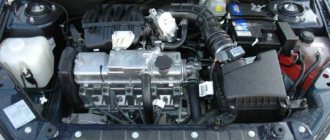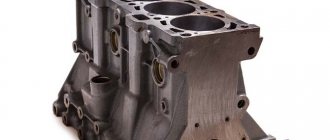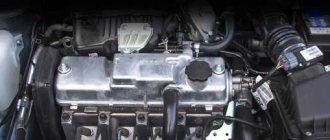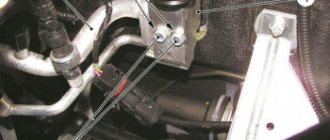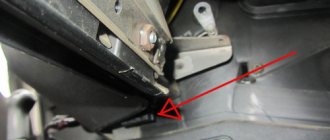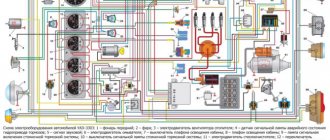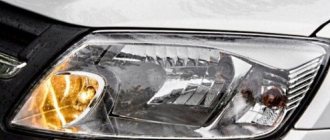Options for 8-valve engines are well known to Lada Granta owners from previous AvtoVAZ models. These engines have indexes 11183 and (11186, 21116), their power is 82 and 87 horsepower, respectively.
Main article: What engines are installed on Lada Granta cars.
Domestic consumers are very afraid of a broken timing belt. Therefore, this issue plays an important role when choosing a car modification.
In such a situation, bending of the valves may occur, which has given rise to the popular saying “ fist of friendship .” There is even slang that refers to motors that bend valves as “plug-in”, and motors that do not have this disadvantage as “plug-in”.
To prevent the belt from breaking, it is necessary to change the belt on time (read more about when it is necessary to change the timing belt according to the recommendation of the factory and the experience of Grantovodov here).
Modification 11183 (Standard package, 82 hp)
Engine 11183 (under the hood of Lada Kalina)
The very first modifications of the Grant car came with a non-lightweight connecting rod and piston group; on such engines the valves do not bend, it all depends on the speed at the moment the belt breaks. These engines were installed on cars in the “Standard” configuration and had the designation 11183. The advantage of this engine is its high-torque power; at the bottom it drives like a diesel engine!
In fact, this is a complete copy of the VAZ-2108 engine, only with an increased volume, and the owners of the nines boasted about stories about how the timing belt broke and nothing happened to the engine.
Engine VAZ 11183, 1.6 l
The VAZ 11183 engine was designed for the Kalina car. The 21114 engine was taken as the basis, the engine markings changed (1 instead of 2 at the beginning of the internal combustion engine designation), the design of the crankshaft and cylinder head. Changes were necessary to increase the volume to 1.6 liters, and the use of existing parts was necessary to reduce the cost of the power drive.
Characteristics of motor 11183
The official AvtoVAZ manual contains a description of the parameters of the ICE 11183, according to which the technical characteristics are as follows:
| Manufacturer | AvtoVAZ |
| Engine brand | 11183 |
| Years of production | 2004 – … |
| Volume | 1596 cm3 (1.6 l) |
| Power | 60 kW (82 hp) |
| Torque moment | 120 Nm (at 2700 rpm) |
| Weight | 112 kg |
| Compression ratio | 9,8 |
| Nutrition | injector |
| Motor type | in-line |
| Injection | electronic multipoint |
| Ignition | modular |
| Number of cylinders | 4 |
| Location of the first cylinder | TVE |
| Number of valves on each cylinder | 2 |
| Cylinder head material | aluminum alloy |
| Intake manifold | plastic receiver, electronic throttle |
| An exhaust manifold | combined with catalyst |
| Camshaft | from 21114 |
| Cylinder block material | cast iron |
| Cylinder diameter | 82 |
| Pistons | ordinary |
| Crankshaft | original with increased crank stroke |
| Number of main bearings | 5 |
| Piston stroke | 86 mm |
| Fuel | AI-92-95 |
| Environmental standards | Euro-3 |
| Fuel consumption | highway – 6.2 l/100 km mixed cycle 7.6 l/100 km city – 8.8 l/100 km |
| Oil consumption | 0.5 l/1000 km |
| Engine oil for 11183 | 5W-30 and 10W-40 |
| Engine oil volume | 3.5 l |
| Operating temperature | 95° |
| Motor life | declared 150,000 km, real 300,000 km |
| Adjustment of valves | washers between camshaft cams and tappets |
| Cooling system | forced, antifreeze/antifreeze |
| water pump | plastic impeller |
| Candles for 11183 | BPR6ES, A17DVRM |
| Gap between spark plug electrodes | 1.1 mm |
| Timing belt | Gates |
| Cylinder operating order | 1-3-4-2 |
| Air filter | Nitto, Knecht, Fram, WIX, Hengst |
| Oil filter | catalog number 90915-10001 replacement 90915-10003, with check valve |
| Flywheel | from 2110 |
| Valve stem seals | code 90913-02090 inlet light code 90913-02088 exhaust dark |
| Compression | cylinder pressure from 13 bar nominal |
| XX speed | 800 – 850 min-1 |
| Tightening force of threaded connections | spark plug - 18 Nm flywheel - 62 - 87 Nm clutch bolt - 19 Nm bearing cap - 68 Nm (main) and 53 (connecting rod) cylinder head - three stages 29 Nm, 49 Nm and 90° |
The operating manual from the manufacturer includes information on lubricants and coolants. In particular, for these engines it is recommended:
- which oil to choose among the variety of fuel and lubricants manufacturers - ZIK, Total Quartz;
Installation 11183 under the hood
By default, the engine circuit contains a potential of 120 - 160 hp, so upgrading it yourself is possible. The 11183 is unpretentious in operation, the power was added initially by the manufacturer, the compression ratio and compression are standard.
Design Features
After modernizing the 21114 engine taken as a standard, the 11183 engine has the following design nuances:
- “high” cylinder block – height increased by 2.3 mm compared to 2110;
- fasteners - the holes are threaded with M12 standard pitch;
- crankshaft – original, steel, forged, crank radius increased by 2.3 mm;
- cylinder head gasket – thickness 1.2 mm, regular;
- combustion chamber – increased to 26 cm3 due to two-stage milling;
- catcollector - short tubes, round block shape.
Engine 21116 (87 hp) - the valves bend!
21116 engine bends valve
This engine is installed on the Lada Granta in the “Norma” configuration. And it also bends the valves, unfortunately.
Main article: Engine 21116: reviews, service life before major overhaul - a detailed review of the engine from Grantovodov!
Engine 21116 (87 hp) is one of the most common in Lada Granta cars.
In order to increase power, AvtoVAZ designers had to install a lightweight piston group in the 114 engine. This has led to the fact that the space for the recesses in the pistons is now completely absent, which means that the piston will 100% bend. Since the piston has become thinner, with a high degree of probability the piston, after “meeting the valves,” will also become unusable and fall apart.
The only difference between 21116 and 11186 is that the first is installed with an imported connecting rod and piston group, and the second with a domestic one.
Bends valves on the following engines
- 16-valve engine, 1.5 liters. Although it is no longer installed on cars, at one time there were quite a lot of them on the tenth family. That's when the owners of these cars felt what it was like. Using the 2112 as a personal example, my valves bent 2 times. And in both cases, not even 10,000 km had passed after replacing the timing belt.
- Model 21126, which is currently installed on both Kalinas and Priors and Grants. As is already known, a collision between valves and pistons is also inevitable when the belt breaks. Moreover, repairs can be very expensive, since in addition to all this, the entire piston system can break, starting from the pistons themselves and ending with scuffs on the cylinders and bent connecting rods.
- Modification 21116, which is now installed on both Grants and Kalinas recently. Although this 8-valve unit has remained virtually unchanged, it will bring a lot of trouble when pistons and valves meet. This is due to the fact that the piston group in this engine is lightweight, so there is no space left for the recesses in the pistons - accordingly, the valves bend.
- 1.4 16-cl. For the first time the engine was installed on Kalina and it is also unsafe, although quite economical.
- VAZ 21127, which will be installed on the Lada Kalina for the first time. It has a volume of 1.6 liters with a similar design to its predecessor from Priora, but with slightly more power. It also belongs to this list of “dangerous” motors.
Repair (cost, warranty)
Repair in the simplest situation will start at 15 thousand rubles, depending on the region and the qualifications of the technician. The saddest thing is that these situations also arise at short mileage, about 15,000 km. But in this case, you can still contact your official dealer for warranty. This type of work is guaranteed.
Since when the timing belt breaks, the valves also break on 16 valves, a heated discussion has developed on our website about which engine is better: 8 or 16 valves.
How to check the condition of the timing belt?
To visually check the timing belt, you must remove the timing cover. This is not difficult to do; with 8 valves there is a lot of space under the hood. Remove the cover and begin a visual inspection of the belt. It should be like new, without cracks or rips, without dirt or deposits, and dry.
If the condition of the belt causes concern, then it must be replaced, for more details, see the article: replacing the timing belt on an 8-valve Granta.
How to check the condition of the pump and tension pulley?
To check the condition of the pump, it is necessary to remove the lower half of the timing cover. Next, release the belt tension by loosening the tension roller. Check the functionality of the pump, spin it and see if there is any play. If there is play, then do not delay and change the pump, as it may jam in the near future.
The tension roller is checked for play in the same way.
You should also be alerted to extraneous noises when the engine is running. A sign of imminent failure of the pump and rollers is the sound of “rustling” of these elements.
There have been cases of timing belt breakage and valve bending as a result of a jammed pump and on a mileage of no more than 20,000 km.
But still, fears on this score do not go away. Therefore, it is first recommended to find out whether the valves on the 8-valve and 16-valve Grant bend, and which engine models are most reliable for operation.
Bends valves on the following engines
- 16-valve engine, 1.5 liters. Although it is no longer installed on cars, at one time there were quite a lot of them on the tenth family. That's when the owners of these cars felt what it was like. Using the 2112 as a personal example, my valves bent 2 times. And in both cases, not even 10,000 km had passed after replacing the timing belt.
- Model 21126, which is currently installed on both Kalinas and Priors and Grants. As is already known, a collision between valves and pistons is also inevitable when the belt breaks. Moreover, repairs can be very expensive, since in addition to all this, the entire piston system can break, starting from the pistons themselves and ending with scuffs on the cylinders and bent connecting rods.
- Modification 21116, which is now installed on both Grants and Kalinas recently. Although this 8-valve unit has remained virtually unchanged, it will bring a lot of trouble when pistons and valves meet. This is due to the fact that the piston group in this engine is lightweight, so there is no space left for the recesses in the pistons - accordingly, the valves bend.
- 1.4 16-cl. For the first time the engine was installed on Kalina and it is also unsafe, although quite economical.
- VAZ 21127, which will be installed on the Lada Kalina for the first time. It has a volume of 1.6 liters with a similar design to its predecessor from Priora, but with slightly more power. It also belongs to this list of “dangerous” motors.
On which Grant engines do the valves bend when the timing belt breaks?
Current Grant owners claim that not all 8-valve engines are problematic. In particular, the “Standard” package is equipped with a truly high-quality power unit and will not cause serious damage to its future owner.
But “Norma” can make the driver worry, because a broken timing belt will lead to the need for long-term and expensive repairs. The differences between these engines, which are similar at first glance, lie in different equipment, so you need to pay careful attention to the type of unit when buying a car.
An engine marked 11183 (previously 2111) is quite noisy, but if the timing belt breaks, the valves will remain intact and undamaged. But many buyers would like to know whether the Lada Granta engine 11186 bends the valves, and how inevitable such a problem is.
Breakdowns will not occur if the car is inspected and diagnosed in a timely manner. But for unit 11186 (formerly 21114), even periodic checks will not always be a preventative measure.
Features of the 11186 engine are reduced operating noise, low fuel consumption and increased power. But in addition to the advantages, the modified power unit also received some problem areas: a new connecting rod and piston system. Its main difference is the lighter weight achieved as a result of shortening the pistons. As a result, the reduced space did not allow for practical and safe placement of the mechanisms.
Does engine 11186 bend valves?
The problem of a broken timing belt and subsequent damage to the valves was familiar to many Lada Kalina owners. The improved Granta, according to many buyers, has lost this problem.
But still, fears on this score do not go away. Therefore, it is first recommended to find out whether the valves on the 8-valve and 16-valve Grant bend, and which engine models are most reliable for operation.
On which Grant engines do the valves bend when the timing belt breaks?
Current Grant owners claim that not all 8-valve engines are problematic. In particular, the “Standard” package is equipped with a truly high-quality power unit and will not cause serious damage to its future owner.
But “Norma” can make the driver worry, because a broken timing belt will lead to the need for long-term and expensive repairs. The differences between these engines, which are similar at first glance, lie in different equipment, so you need to pay careful attention to the type of unit when buying a car.
An engine marked 11183 (previously 2111) is quite noisy, but if the timing belt breaks, the valves will remain intact and undamaged. But many buyers would like to know whether the Lada Granta engine 11186 bends the valves, and how inevitable such a problem is.
Breakdowns will not occur if the car is inspected and diagnosed in a timely manner. But for unit 11186 (formerly 21114), even periodic checks will not always be a preventative measure.
Features of the 11186 engine are reduced operating noise, low fuel consumption and increased power. But in addition to the advantages, the modified power unit also received some problem areas: a new connecting rod and piston system. Its main difference is the lighter weight achieved as a result of shortening the pistons. As a result, the reduced space did not allow for practical and safe placement of the mechanisms.
Why does the Granta 8 valve bend the valve?
The breakdown procedure itself is also equally important to study. Having understood which areas are most susceptible to damage, the owner will be able to pay more attention to them or seek help from specialists.
After diagnostics, our technicians will perform a full service and help you avoid numerous causes of timing belt failure: jamming of the pump, rollers, camshaft or crankshaft. The process of valve damage itself occurs according to the following scheme:
1. The timing belt breaks.
2. The camshaft stops.
3. The crankshaft continues to rotate (the flywheel transmits rotation).
4. The pistons hit the open valves when the timing belt breaks.
Thus, the valves become bent, and in the future they will need to be completely replaced. You can also find out whether the valves of the Lada Granta 8 valve are bent from specialists working at the service station.
After all, a breakdown does not necessarily affect every owner of a domestic car. Damage occurs in exceptional cases when the motorist does not devote enough time to servicing the car. Therefore, the root cause is insufficiently conscientious operation.
Many craftsmen recommend that immediately after purchasing a Granta, you have it checked at a service station, since even small nicks on the shafts can lead to a rupture of the timing belt.
In some cases, changing the belt to a stronger one helps: the factory component may not meet the required load and operating conditions. The tension force must fully comply with the stated recommendations of the manufacturers. Therefore, self-regulation can only worsen the situation.
Why does the Granta 8 valve bend the valve?
The breakdown procedure itself is also equally important to study. Having understood which areas are most susceptible to damage, the owner will be able to pay more attention to them or seek help from specialists.
After diagnostics, our technicians will perform a full service and help you avoid numerous causes of timing belt failure: jamming of the pump, rollers, camshaft or crankshaft. The process of valve damage itself occurs according to the following scheme:
1. The timing belt breaks.
2. The camshaft stops.
3. The crankshaft continues to rotate (the flywheel transmits rotation).
4. The pistons hit the open valves when the timing belt breaks.
Thus, the valves become bent, and in the future they will need to be completely replaced. You can also find out whether the valves of the Lada Granta 8 valve are bent from specialists working at the service station.
After all, a breakdown does not necessarily affect every owner of a domestic car. Damage occurs in exceptional cases when the motorist does not devote enough time to servicing the car. Therefore, the root cause is insufficiently conscientious operation.
Many craftsmen recommend that immediately after purchasing a Granta, you have it checked at a service station, since even small nicks on the shafts can lead to a rupture of the timing belt.
In some cases, changing the belt to a stronger one helps: the factory component may not meet the required load and operating conditions. The tension force must fully comply with the stated recommendations of the manufacturers. Therefore, self-regulation can only worsen the situation.
You should also contact a specialist if primary signs appear that may indicate a subsequent belt rupture. It could be minor noise from the timing drive. It is this that will indicate possible wear or partial wedge of the rollers or pump.
All these factors are decisive and can lead to the need for expensive repairs, and in extreme cases, to calling a tow truck if the driver was outside the city at the time of the rupture. The owner of the Grant needs to take into account all the considered nuances and solve the slightest problems immediately after they arise.
Engine 21116 with 87 hp. is one of the most popular among Lada Granta car owners. This is due to the fact that it is this modification of the engine that is included in the most popular “Norma” configuration.
Technical characteristics of VAZ 11183
| Manufacturer | AvtoVAZ |
| Engine brand | 11183 |
| Years of production | 2004 – … |
| Volume | 1596 cm3 (1.6 l) |
| Power | 60 kW (82 hp) |
| Torque moment | 120 Nm (at 2700 rpm) |
| Weight | 112 kg |
| Compression ratio | 9,8 |
| Nutrition | injector |
| Motor type | in-line |
| Injection | electronic multipoint |
| Ignition | modular |
| Number of cylinders | 4 |
| Number of valves on each cylinder | 2 |
| Cylinder head material | aluminum alloy |
| Intake manifold | plastic receiver, electronic throttle |
| An exhaust manifold | combined with catalyst |
| Camshaft | from 21114 |
| Cylinder block material | cast iron |
| Cylinder diameter | 82 |
| Crankshaft | original with increased crank stroke |
| Number of main bearings | 5 |
| Piston stroke | 86 mm |
| Fuel | AI-92-95 |
| Environmental standards | Euro 2-3 |
| Fuel consumption | highway – 6.2 l/100 km mixed cycle 7.6 l/100 km city – 8.8 l/100 km |
| Oil consumption | 0.5 l/1000 km |
| Engine oil for 11183 | 5W-30 and 10W-40 |
| Engine oil volume | 3.5 l |
| Operating temperature | 95° |
| Motor life | declared 150,000 km, real 300,000 km |
| Adjustment of valves | washers between camshaft cams and tappets |
| Cooling system | forced, antifreeze/antifreeze |
| water pump | plastic impeller |
| Candles for 11183 | BPR6ES, A17DVRM |
| Gap between spark plug electrodes | 1.1 mm |
| Cylinder operating order | 1-3-4-2 |
| Flywheel | from 2110 |
| Compression | cylinder pressure from 13 bar nominal |
| XX speed | 800 – 850 min-1 |
| Tightening force of threaded connections | spark plug – 18 Nm flywheel – 62 – 87 Nm clutch bolt – 19 Nm bearing cap – 68 Nm (main) and 53 (connecting rod) cylinder head – three stages 29 Nm, 49 Nm and 90° |
The engine uses a connecting rod and piston group 2110. In order not to increase the compression ratio, the shape of the combustion chamber was increased and improved. The cylinder head with an enlarged combustion chamber received the index “11180”. There is a corresponding marking on the tide of the head. There are a number of design solutions that distinguish the VAZ 11183 engine from the VAZ 21114 engine. The electrical system uses a generator 5132.3771 (90 A). A new bracket was used to mount the generator. The generator belt tensioning mechanism is original. The VAZ 11183 engine is equipped with a serpentine alternator belt 1118-1041020 - 6RK882 (882mm).
Increase in power (tuning) 11183
• Increase engine power to 90 hp. With. It is possible if you replace the existing camshaft with “OKB Dinamika 108” or “Nuzhdin 10.93” and install a split gear. With the correct phase settings, the power unit can develop power up to 90 hp. With. By installing a receiver, an enlarged 54 mm throttle body and a Spider 4-2-1 exhaust, you can increase the engine power to 100 hp. With. • After porting the cylinder head and intake manifold, the engine power will increase to 115 hp. With. True, for this it is necessary to replace the standard valves with lighter ones (T-shaped). By replacing the piston group with a lighter one (for example, from a LADA Priora car), we get a power of more than 120 hp. With. The same result can be obtained if you install on the engine: compressor PK-23-1; camshaft “Nuzhdin 10.42” or “Nuzhdin 10.63”. The power of the 8-valve power unit can be further increased, but this will lead to a significant reduction in its service life.
Engine tuning VAZ 11183 compressor - video
Dynamics
External view of engine 21116
This is not a racing car, but there is enough power for both city driving and highway driving. If we compare it with the 16-valve engine of the Lada Granta, which is installed on the Luxury versions, then it has more torque at the bottom. This means that you can drive in 5th gear at a speed of 40 km/h.
For example, you are driving at 5 speed, the traffic light in front lights up red. You release the gas pedal and the car brakes with the engine. The light turns green and you can continue driving in 5th gear even if the vehicle speed has dropped to 40 km/h.
I was pleasantly surprised by the elasticity of the motor. Considering that I previously owned a Priora, and it has a 98 hp engine, then the engine is 87 hp. I like grants better.
Pulls like a locomotive!
Engine Features
Due to the design of the car's cooling system, the engine does not warm up above 80 degrees. The management of AvtoVAZ does not see anything wrong with this; they have an official information letter on this matter. You can read it in the material: What is the operating temperature of an 8 valve engine.
The engine design is as simple as an axe. There are no hydraulic compensators, no sores were noticed. Mostly problems can arise due to malfunctions in the engine management system.
Video of acceleration to 100 km per hour
I haven’t shot my video yet, it’s winter, so we’ll wait for the weather to warm up. That's when I'll post it on our YouTube channel. In the meantime, here's a video from Grantovodov.
Here's another interesting video. It is interesting because the measurement is made using an application with a navigator , which means that the speedometer readings are more accurate if the navigator is well calibrated. Everyone knows that the higher the speed, the more the car’s speedometer lies.
Design Features
After modernizing the 21114 engine taken as a standard, the 11183 engine has the following design nuances:
- “high” cylinder block – height increased by 2.3 mm compared to 2110;
- fasteners - the holes are threaded with M12 standard pitch;
- crankshaft – original, steel, forged, crank radius increased by 2.3 mm;
- cylinder head gasket – thickness 1.2 mm, regular;
- combustion chamber – increased to 26 cm3 due to two-stage milling;
- catcollector - short tubes, round block shape.
Cylinder head 11183
To reduce manufacturing costs, a connecting rod-piston group, a pulley and a crankshaft flywheel from the 2110 engine are installed in the engine. The volumes of the combustion chambers are increased for the engine with the sole purpose of ensuring a compression ratio of 9.6 - 10.0.
The manufacturer does not provide hydraulic compensators in this internal combustion engine, therefore, on the one hand, the use of lower quality oil is allowed. On the other hand, the savings in the operating budget when using cheap lubricants are “eaten up” by the costs of periodically adjusting the valves in a service station, since the manufacturer recommends doing it more often.
The main attachments are driven by their own belts. The design of tensioners (for example, a generator) leaves much to be desired. But the internal combustion engine allows you to increase power in the following ways. Moreover, a reasonable boost does not require major repairs to be carried out more often than the established deadline.
Alternator belt drive
Even without improving the performance, the engine is high-torque and torquey, and produces 200% of the service life declared by the manufacturer. The available repair dimensions of the piston group make it possible to increase the service life, taking into account several overhauls, up to a million kilometers.
Noise level
I switched to this car from the Renault Megane 2. My Renault was equipped with a 1.6-liter engine, a power of 113 horses, and the number of valves was 16.
After it, the Granta engine works like a tractor. Regardless of the car's mileage. Even the engine on the carburetor VAZ-21093 seemed quieter to me.
I specifically compared the noise level on a new Grant with a mileage of 5,000 km and on mine with a mileage of 55,000 km. As it warms up, the sound becomes quieter, but most likely you just get used to it.
Read more about warming up the engine in the article: the need for warming up: myth or fact?
But it is also worth considering that there are no hydraulic compensators, so you will have to adjust the valves. By the way, the engine in the luxury version (98 hp) also rumbles.
Malfunctions: causes, elimination
If the timing belt of the drive breaks, the 11183 motor does not bend the valve, but it has the following typical breakdowns:
| Floating speed | 1) malfunction of the ignition module 2) gasket breakdown 3) valve burnout 4) failure of the TPS sensor | 1) module replacement 2) installing a new gasket 3) valve replacement 4) repair or replacement of the throttle position sensor |
| Extraneous noise | 1) misadjustment of valve clearances 2) piston wear 3)bearing wear 4) production of liners | 1)adjustment with valve gaskets 2) replacement of pistons, rings 3)replacement of bearings 4) use of new liners |
| Alternator belt break | excessive tension, manufacturing defect | Regular check, replacement as necessary |
Since a feature of the ICE 11183 is a well-thought-out design of valves and pistons, overhauls in most cases are carried out on time without additional user investment.
TPS sensor for 11183
Engine life
Under the hood in the “Norma” configuration
The question that causes the most controversy. Officials talk about a mileage of 150,000 km before major repairs; some have traveled 200 thousand km or more without problems. I have a friend who already had his engine repaired at 40 thousand km because the timing belt broke. Yes, the engine here is “plug-in” - this means that if the timing belt breaks, the pistons meet the valves and you can see the fist of friendship.
Engine resource 87 hp. 21116 according to the passport - 150,000 km!
Studying the forums, based on my own experience, I can say that it all depends on how you will operate the engine. The most banal thing: the quality of the oil (choose correctly) and engine operating modes - this is what the mileage before you need to do major repairs depends on.
Main pros and cons of engines
VAZ 11183 (1.6-8cl):
Pros:
- Well-known and proven engine (repaired in many services, availability of spare parts).
- Not plug-in, if the timing belt breaks there is little chance of the valves meeting the pistons.
- Good traction at the bottom.
Minuses:
- Increased engine noise and vibration (often a sound like a diesel engine appears).
- Requires periodic valve adjustment.
- Air conditioning is almost never installed at the factory on this engine.
VAZ 11194 (1.4-16cl):
Pros:
- Lowest fuel consumption compared to other engines.
- Quiet operating sound and no vibration.
- Good acceleration dynamics up to 6 thousand rpm on the highway.
- Does not require valve adjustment, without possible repairs, it only requires oil and filter changes.
Minuses:
- If the timing belt breaks, the valves bend, and you have to change both the valves and the piston (the German piston is not very available).
- Increased oil consumption is often observed, especially after 40,000 - 60,000 km.
VAZ 21126 (1.6-16cl):
Pros:
- Quiet operating sound and no vibration.
- The best acceleration dynamics of all the engines presented, the most powerful engine in the Lad line.
- Does not require valve adjustment, without possible repairs, it only requires oil and filter changes.
Minuses:
- If the timing belt breaks, the valves bend.
VAZ 21126 (1.6-16cl):
This engine is completely new and there is very little information on it, as it turned out the first drawback in it: like a 16 valve engine, if the timing belt breaks, it bends the valves, perhaps it will transfer some of the sores from the 1.4 16kl engine.
Reviews from car owners about the 87 hp engine.
Most reviews are positive.
Mostly problems occur due to low-quality fuel and lubricants. The engine may start to stall and run intermittently (floating idle, stalls, loss of power, etc.). In this case, the “Check Engine” malfunction icon (indicator) should light up on the instrument panel.
The engine pulls well at low end; on the highway, even with a full load, there is enough power. This is especially noticeable when compared with a Ford Focus automatic: engine capacity 1.6, power 100 horsepower. Granta drives more fun, Focus “deflates” after 80 km per hour. As for Focus - personal experience, I owned just such a car.
Fuel consumption
Even in a mixed cycle with traffic jams, consumption will not exceed 10 liters per hundred!
Fuel consumption is good. Even in a mixed cycle with traffic jams, consumption will not exceed 10 liters per hundred. My consumption is 8 liters in the city, 6 on the highway. This is on 92 gasoline. I checked from tank to tank, it roughly matches the readings of the on-board computer. On 95 gasoline, which is what AvtoVAZ recommends using, fuel consumption should become even less.
Read more about car consumption in the article: passport and real data on fuel consumption.
If your consumption exceeds the norm, then you need to look for a malfunction. Do not delay troubleshooting, as your engine may be overloaded.
Starting in the cold
In cold weather it starts, even after a long stay. The main thing is a good battery, a working fuel pump and power system.
If your car does not start, then this article will help you.
Engine 11183 technical specifications
Based on the data available in the official documentation for engine model 11183, the characteristics and main technical parameters are described in the following table:
| Internal combustion engine brand | 11183 |
| Total engine capacity | 1,596 liters |
| Developed power | 82 horsepower |
| Maximum torque | 120 N.m at 2700 crankshaft rpm |
| Motor weight | 112 kg |
| Type of formation of fuel mixtures | injection |
| Compression ratio | 9,8 |
| Cylinder arrangement | in-line |
| Number of cylinders | 4 things |
| Cylinder head material | Aluminium alloy |
| Block material | cast iron alloy |
| Diameter of one cylinder | 82 mm |
| Piston stroke length | 86 mm |
| Fuel type | Gasoline AI-95 |
| Environmental Compliance | Euro-3 |
| Recommended motor oil viscosity index | 5W-30 – for summer; 10W-40 – for winter |
| Lubricant quantity | 3.5 liters |
| Engine operating temperature | 95°С |
| Declared service life of the power unit | 150,000 km |
| Real | 300,000 respectively |
| Compression | cylinder pressure 13 – 14 bar (not higher) |
Engine malfunctions and repairs Grants 21116/11186
Before us is the 21116 engine, which is a modified 21114 1.6 liter engine. which in turn is based on the well-known 21083 engine. The differences between the 21116 engine and the VAZ 21114 are in the use of the Priorovsky lightweight (39%) SPG produced by Federal Mogul, the cylinder block is also from the Priorovsky VAZ 21126 engine. The differences between the 21116 engine and the 11186 are in the piston manufacturer, for 11186 it is manufactured by AvtoVAZ, for 21116 - Federal Mogul, that's all)) What's good about the engine: noise and gasoline consumption have decreased, environmental friendliness has increased and power has increased noticeably (almost at the level of the 124 16V), at the same time a serious drawback has appeared: if the timing belt breaks, the VAZ 21116 engine bends the valve. A lower service life is also noted compared to the old 11183 engine, despite the fact that the plant declares the service life of the VAZ 21116 engine to be 200 thousand. km. Engine VAZ 21116 1.6 l. injection in-line 4-cylinder with an overhead camshaft, the gas distribution mechanism is belt driven. The operating temperature of the Grant 11186 engine is 95 degrees. Regarding the problems, you are hearing noise and knocking from under the hood in the Lada Granta engine, or it is tripping, wasting... the article on the previous versions of this engine (2111) describes the causes of these malfunctions, read on.
Malfunctions and repairs of the VAZ 11183/21114 engine
Engine 21114, second name 11183, is a further development of the 2111 1.5 liter. and actually, 083 engines. The cylinder block of the 21114 engine is 2.3 mm higher compared to the 2111, the piston stroke has increased from 71 mm to 75.6 mm, due to this the volume has become 1.6 liters. The environmental performance of the unit has also increased, it has also become more reliable, less capricious than the VAZ 2111 engine, and has an advantage in elasticity and high-torque. This engine has many names: 21114, 11183, engine 2114, Kalina engine. The difference between the VAZ 21114 engine and the VAZ 11183 is that they are assembled in different places of the plant, physically the engine is the same. Among the people, the names 2114 engine (the 1.5 liter was also called that) and also the Kalina engine took root. The engine itself is an in-line 4-cylinder injection engine with an overhead camshaft, the gas distribution mechanism is belt driven. The service life of the VAZ 11183 (21114) engine, according to the manufacturer’s data, is 150 thousand km; in practice, the engines run more than 200-250 thousand km. There are cases up to 300 thousand km. Owners of fours and other cars with this motor often wonder, does engine 21114 bend the valves? The answer is simple: if the timing belt breaks, your engine will not bend, but with a sporty, evil camshaft there is a chance. Among the disadvantages, it is worth noting the requirements for periodic adjustment of the valves, as well as the engine noise, reminiscent of a diesel engine. About noises and knocks, they exist, in addition to them, the engine troits, heats up or does not warm up, etc., you can read about the causes of this or that problem HERE.
Engine tuning Lada Granta, VAZ 21116, VAZ 11186
Atmospheric tuning of the Grant engine
Let's consider the potential of the 21116 8V engine without replacing the cylinder head with a 16 valve (The 126 16V engine and its modifications are mentioned in a separate article). The first stage, already familiar to us from tuning the 21114 engine, is replacing the camshaft with a Nuzhdin 10.93, installing a split gear, and adjusting the phases. We hang a receiver on top, a 54 mm damper and a 4-2-1 spider exhaust with this kit the engine power will be about 100 hp. With additional modifications and milling of the cylinder head, as well as the intake manifold, we will get about 120 hp.
Compressor for Lada Granta
Another method of obtaining similar output from a 116 engine is to install a PK-23-1 compressor with a pressure of 0.5 bar on the piston drain. With a need shaft of 10.63 or 10.42 the result will be better. The well-known video clearly explains everything that is required for the successful implementation of a project based on 2113; all this can be easily recreated on Grant, Kalina, Priora and other cars.
Attention MAT (18+)
The 8-valve head allows you to increase the power above 120 hp, but at the same time the costs of repairing the VAZ 21116 engine will also rise. The potential can be significantly increased by installing a 16-valve cylinder head, with a receiver, damper and exhaust of the same 120 hp. we get it easily and without loss of resource.
Engine VAZ 11183 Gnet Li Valve
Content
Engine specification 21114
Years of issue. (2004. Our days) Block material. cast iron Power supply system. injector Type. line Number of cylinders 4 Valves per cylinder. 2 Piston stroke. 75.6 mm Cylinder diameter is 82 mm Compression ratio is 9.6 Engine capacity 1596 cm3 Power. 81 hp / 5200 rpm Torque. 125 Nm / 3000 rpm Fuel. AI95, 92 (according to unofficial data) Fuel consumption. 8.8 liters in the city. | The track is 6.2 liters. | mixed 7.6 l / 100 km Oil consumption. 50 g / 1000 km Oil type: 5W-30 5W-40 10W-40 15W40 How much HP and KW does 21114 11183 have: 3.5 liters. When replacing, fill in 3.2 liters.
Resource: 1. According to the plant. 150 thousand km 2. In practice. up to 250-300 thousand km
TUNING Potential. 180 hp No loss of resource. up to 120 hp
Malfunctions and repairs of the VAZ 11183/21114 engine
Engine 21114, 2nd title 11183 is a future development of the 2111 1.5 liter. but in fact the engines are 083. The cylinder block of the 21114 engine is 2.3 mm higher than that of the 2111, the piston stroke is increased from 71 mm to 75.6 mm, resulting in a volume of 1.6 liters. The environmental characteristics of the unit have also increased, it has become more reliable and less capricious, if the VAZ 2111 engine has the advantage of elasticity and high torque. This engine has a huge number of names: engine 21114, 11183, engine 2114, Kalina engine. The differences between the VAZ 21114 and VAZ 11183 engines are that they are assembled in different installation locations, with only one engine at the physical level. People are accustomed to the engine with the name 2114 (1.5 liters. Also called), also to the viburnum engine.
READ Replacement Spark Plugs Largus 16 Valves
The engine itself is an inline 4-cylinder with an overhead camshaft; the timing mechanism has a belt drive. According to the manufacturer, the service life of the VAZ 11183 (21114) engine is 150 thousand km; in practice, the motors travel more than 200-250 thousand km. There are cases up to 300 thousand km. Owners of Thursdays and other cars with this engine are often surprised, but does the 21114 engine bend the valve? The answer is simple: when the timing belt breaks, your engine won't sag, but the sports camshaft has a chance. Disadvantages include multiple valve adjustment requirements and diesel-like engine noise. As for noise and knocking, they are there in addition to the engine engines, they heat up or don’t heat up, and so on. You can read about the reasons for this or that obstacle here.
Engine adjustment VAZ 11183 (21114)
Let's consider the potential of the 11183 8V engine without replacing the cylinder head with 16 valves (124 engines and its improvements are mentioned in a separate article) The more common method is to replace the camshaft with an OKB Dynamics 108 or Nuzhdin 10.93, install a separate gearbox, adjust the phases with this, we get about 85 -90 hp and cheerful delight above. We will not skimp on the receiver, 54 mm flap and 4-2-1 spider ejection, this configuration will work better than the 16-valve 124 engine, and at the same time the price of modifying the VAZ will be completely down to earth. Extrusion to the maximum will allow us to refine the cylinder head and intake manifold, lightweight T-valve valves and milling of the cylinder head. The estimated power of the VAZ 21114 engine in this case will reach 110-115 hp. To make the engine easier to rotate, the Priorov's lightweight piston can deliver and receive 120 hp.
READ Ford Transit 2018 Fuel Filter Replacement
Kalina motor compressor
Another way to get similar returns. install the PC-23-1 compressor, and to increase its efficiency we will add Vali Nuzhdin 10.42 or 10.63. The famous video clearly explains everything needed for a successful project.
Attention MAT (18)
You can increase the power without using a turbine up to 170 hp. and higher, but the service life of the VAZ 11183 engine is noticeably reduced. The right step is to increase the potential by increasing the efficiency of the engine, namely installing a cylinder head with 16 valves, which together with the valve, receiver and exhaust pipe 51 will give 110-120 hp. without significant loss of resources.
Turbo viburnum engine
A turbocharger configuration based on an 8-valve cylinder head is described here. The principle is the same.
Source
